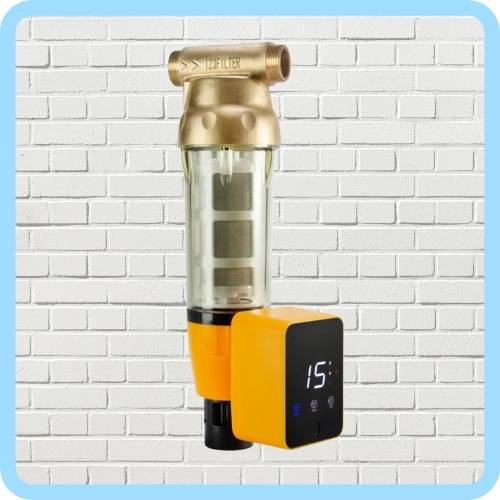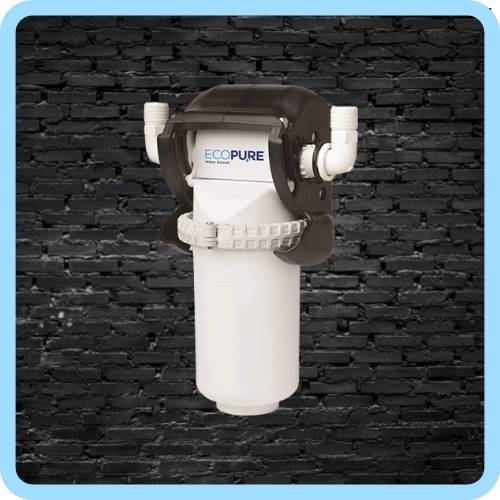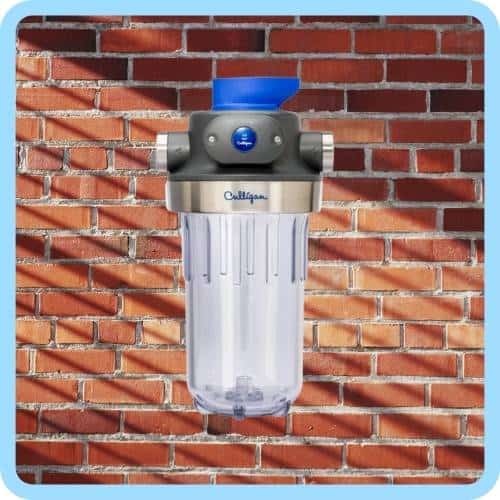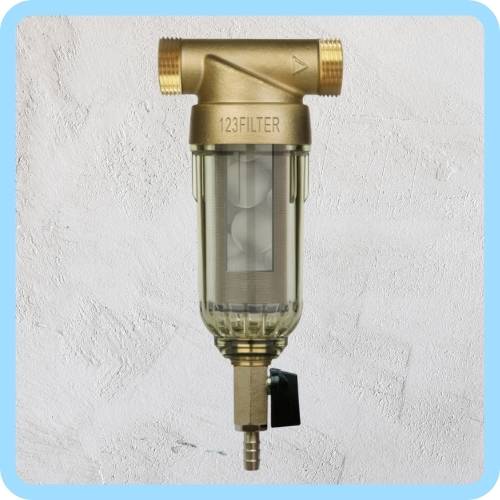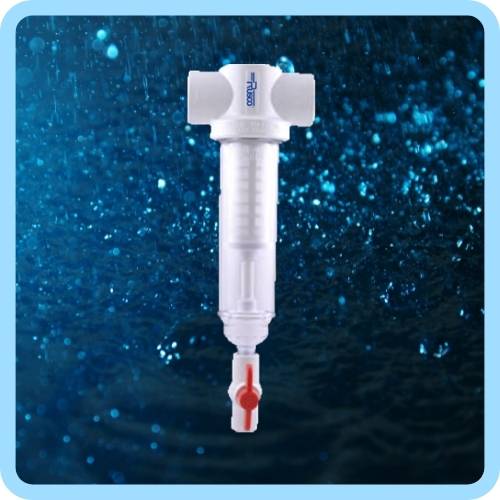We know that sediment, sand, silt, and other contaminants can impact the lifespan of your whole house water filtration system. But how can you ensure you’re choosing the best one for your home’s well water?
I’ve been using water filters since 2015. And since starting this site I’ve reviewed over fifty different models. To write this review I downloaded every user manual, checked every single product description, and read hundreds of user reviews. I also sent a couple of emails to the manufacturer where things weren’t quite clear.
The Best Overall Sediment Filter for Well Water is the iSpring WSP50ARB Spin Down Sediment Well Water Filter. The best sediment water filters for well water have the correct micron rating for your water, are low maintenance. So we tend to prefer spin-down filters (with auto-flush if you can afford it).
Below you’ll find reviews of the five of the best sediment filters I could find. There’s also a Buyer’s Guide and a thorough explanation of sediment and why we need a sediment water filter to remove it.
Top Five Sediment Filters for Well Water
- iSpring WSP50ARB Spin Down Sediment Well Water Filter
(Best Overall) - Culligan WH-HD200-C Whole House Heavy Duty Sediment Filter
(Budget Pick) - EcoPure EPWHE Whole Home Sediment Filter
(Best for Reverse Osmosis) - iSpring WSP-50SL Whole House Spin Down Sediment Water Filter with Siliphos (Best for Hard Water)
- Rusco 1-1/2-250-F Polyester Screened Spin-Down Filter
(Best Budget Spin-Down Filter)

Reviews: Sediment Filters for Well Water
iSpring WSP50ARB Spin Down Sediment Well Water Filter, Reusable with Touch-Screen Auto Flushing Module
Best Overall Sediment Filter for Well Water
- Filter Type: Spin Down Stainless Steel Mesh
- Inlet / Outlet Size: 1-inch MNPT and 3/4-inch FNPT / or push-fit 3⁄4-inch
- Micron Rating: 50
- Price: $$$$
- Flow rate: 35GPM
- Max Pressure: 90 PSI
- Auto flush? Yes
The iSpring WSP50ARB Spin Down Sediment Water Filter is our overall choice for the best sediment filter for well water. It’s extremely effective, low-maintenance, and you’ll rarely need to change the filter (if ever). What sets this model apart is the touch screen auto-flush module; you’ll never need to remember to do a manual flush again!
The stainless steel mesh filter has a rating of 50 microns. 50 microns will remove sediment particles, rust particles, sand particles, and other debris. This extends the life of other filters in your plumbing system and protects your appliances.
If your well water has higher levels of sediment particles then a 50-micron filter may get clogged too quickly, and require too frequent flushes. If this is the case, a 100-micron filter is available.
The Auto Flushing Module makes it easy to automatically flush on a preset schedule. This saves time and makes maintenance fast and effortless. Use the HD touch screen to adjust flushing frequency from 1 day up to 99 days apart. This is great if you’re away from home regularly, if the filter is installed down in a dark basement that you don’t visit often, or if you’re just a bit forgetful!
It’s generally recommended to flush the system for at least 30 seconds every week. This is enough time to get rid of any sediment that might build up and protect your home from contamination. But you can do it every day, if necessary.
The only other maintenance required is to take out the filter and clean it if it gets dirty. Most people find this is only necessary every 8 – 12 months, but you can check if the filter looks clogged or dirty through the clear filter housing to check.
There’s also a 30-day money-back guarantee, a one-year limited warranty, and lifetime tech support directly from iSpring. This is a huge plus for iSpring filters. Many owners of this system have commented how helpful iSpring’s customer service team is. If you’re missing any parts or fittings, iSpring will advise you exactly what to buy and send parts directly to you within a few days.
The majority of people find installation easy. This is because there are two types of threads on both ends of connectors: 1-inch MNPT and 3/4-inch FNPT; or push-fit 3⁄4-inch fittings. So most people won’t need any extra trips to the hardware store for fittings and adaptors.
A few people have found that the instructions for the auto-flush module are too text-heavy and lack clear images. This was solved by calling iSpring customer service to receive clearer directions.
The iSpring WSP50ARB system is a great choice for people who want an easy-to-install, reliable, and low-maintenance sediment filter, without the annoyance of regular manual flushing.
Culligan WH-HD200-C Whole House Heavy Duty 1″ Inlet/Outlet Filtration System
Best Sediment Filter with Cartridge Filters (Budget Pick)
- Filter Type: Choice of depth and surface cartridge filters
- Inlet / Outlet Size: 1″
- Price: $
- Flow rate: 10 GPM
- Max Pressure: 100 PSI
The Culligan WH-HD200-C is the best quality, cartridge-based sediment filter that we could find. It’s well-built, has a larger inlet/outlet than other systems, and is compatible with the huge range of inexpensive Culligan cartridge filters.
One big advantage of this system is that you can choose the type of filtration you need to match your home’s water quality. Culligan’s range of cartridge filters includes various types of depth and surface filters with micron ratings from 1 – 30. This means you can use it for a pre-filter for all types of systems (and the 1 – 5 micron cartridge filters can even be used for reverse osmosis and UV filtration systems).
The system features a bypass shut-off valve which is useful if the filter becomes clogged or the filter needs replacing. Just activate the bypass valve until the problem is fixed, or the cartridge filter is replaced.
We highly recommend the Culligan WH-HD200-C for people who often forget to change their filters. This is because it has a clear filter housing screen (so you can check how dirty the filter is) and a battery-operated filter change timer which will remind you with a loud beeping noise when it’s time to change your filter.
The system’s rated pressure is 100 PSI (so it won’t work if your household water pressure exceeds that level) with a maximum flow rate of 10GPM.
Some users have had issues with failed seals and worn-out threads. These issues are caused by mistakes during installation, rather than the product itself. You need to take care when connecting male and female fittings or you may damage the threads and break the water-tight seal. For this reason, it’s recommended that you hire a plumber for installation if you’re not experienced.
Overall, this is an excellent product that comes with a two-year warranty and should last for many years. There’s a huge choice of cartridge filters to match your well water’s quality. Plus, it’s made in the USA!
EcoPure EPWHE No Mess Whole Home Water Filtration System
Best for Reverse Osmosis Pre-Filter
- Filter Type: Easy Change Cartridge
- Inlet / Outlet Size: 1”
- Micron Rating: 5
- Price: $$$
- Filter Lifespan: 3 – 6 months
- Flow rate: 9 GPM
- Max Pressure: 100 PSI
The EcoPure EPWHE Whole Home Water Filtration System is a great choice for pre-filtering your well water. It’s easy to install and maintain, and the filters can be changed with no mess.
This filter has a micron rating of 5, which means it will remove particles as small as five microns in diameter from your drinking water. This makes it suitable for pre-filtration before reverse osmosis or UV filtration system.
As well as removing sediment, these filters will also protect your drinking water from harmful chemicals like chlorine. As it filters down to five microns, the water quality improvement will be easily noticeable. Many people report a clear reduction in chlorine smell from their water, as well as noticeably clearer ice cubes.
The EcoPure EPWHE replacement sediment filters have a lifespan of up to six months. And it’s very easy to change the filter. This system has an automatic bypass so you don’t need to shut off your whole water supply when changing filters. You can take the old one out and replace the new one in less than two minutes.
Some people find that the filters for this model need replacing too often. However, this is to be expected if you have high levels of contamination in your well water. The six-month lifespan is for low to medium levels of water contamination.
If you have high levels of sediment in your water, consider using a pre-filter before this system. Another option is a heavy-duty spin-down filter like the iSpring WSP50ARB Spin Down Sediment Water Filter.

Overall, the EcoPure EPWHE Whole Home Water Filtration System is a very user-friendly and affordable option for filtering your drinking water. It’s also the only model on this list that we recommend for use as a pre-filter for a reverse osmosis water filter system.
iSpring WSP-50SL Reusable Whole House Spin Down Sediment Water Filter Softener with Siliphos
Best for hard water wells
- Filter Type: Spin Down Stainless Steel Mesh with Siliphos
- Inlet / Outlet Size: 1″ MNPT + 3/4″ FNPT
- Micron Rating: 50
- Price: $
- FIlter Lifespan:3 – 6 months
- Flow rate: 15 – 20 GPM
- Max Pressure:120PSI
- Auto flush? No
The iSpring WSP-50SL Whole House Spin Down Sediment Water Filter is a great first-stage sediment filter for well water in hard-water areas. In addition to reducing sediment, rust, dirt, and sand, the filter can also help to soften water and prevent scale or corrosion. If your water softener is often clogged with sediment, this model may be what you’re looking for.
We’re reviewing the 50-micron model, which is a good choice for pre-filtration for most people. The filters are also available in 100, 200, 500, or 1000 Microns.
These filters are made from stainless steel mesh. Stainless steel is more durable and less likely to get damaged by large particles or high water pressure.
The added food-grade siliphos softens water and helps to prevent scale and rust. This is great for homes with hard water, but it also requires a little more maintenance than a standard spin-down filter. You’ll need to flush it weekly or even daily (depending on your water quality), as hardness can clog the screen. Many people find it quite satisfying to see how much scale and rust is being removed!
If you have very heavy sediment well and hard water, consider switching up to a 100 or 200-micron screen. This will reduce the number of times you need to flush the system each week. This makes sense as most people usually have further filtration stages later on in their water systems.
It’s well designed and sturdy. The clear sediment filter housing cover means you’ll easily see if the system is clogged and needs flushing.
Another thing we like about Spring spun-down filters is that they have high flow rates. The WSP-50SL can handle 15-20 gallons per minute with a max pressure of 120psi.
One downside is that because it softens the water, you’ll need to completely remove the filter and brush it, or soak it in vinegar if it becomes clogged with scale. This shouldn’t happen more than every few months though.
This is a great sediment filter for well water with excess minerals and scale.
Rusco 1-1/2-250-F Polyester Screened Spin-Down Filter System
Best Budget Spin-Down Filter
- Filter Type: Spin-Down Polyester Mesh
- Inlet / Outlet Size: 1.5″
- Micron Rating: 50
- Price: $$
- Flow rate: 10 – 50 GPM
- Max Pressure: 150PSI
- Auto flush? No
The Rusco1-1/2-250-F is a high-quality, budget-friendly spin-down sediment water filter that can be flushed easily to remove sediment from your well water.
The included polyester filter screen is 250 mesh (rated at 50 microns). This means it will filter out most of the larger particles and sediment in your well water. This makes it a good option as a pre-filter for further filtration systems (but not for a reverse osmosis or UV filtration system as these need a sediment filter rated for 5 microns or lower).
Rusco produces filter screens from between 24 and 1000 mesh (15 – 700 microns). So if you decide you need a different micron rating later on, this can be changed easily and inexpensively.
These filters have an impressive lifespan. Most people find they only need to replace them once per year. In theory, these filters don’t need replacing as long as they are well-maintained and cleaned often. In practice, higher water pressures and sediment damage the water filter screen after a year or so. Replacements aren’t expensive and can be bought for around a third of the price of the whole system.
One downside of this system is that it doesn’t include an auto-flush. If you don’t remember to do it yourself, sediment will accumulate and eventually clog the system.
Fortunately, the system has a clear filter housing cover so the sediment build-up is visible at all times. As long as you check it regularly (at least once a week), you’ll easily be able to see when it needs flushing.
Flushing is simple. All you need to do is open the red-handled shut-off valve for 5 seconds. We recommend setting an alarm so you don’t forget to check it.
Overall, this system is a great, budget-friendly option for filtering out sediment from your well water. And it’s easy to maintain too!
How to Choose the Best Sediment Filter for Well Water
What is sediment?
Sediment is the term used to describe dirt and other material that has settled at the bottom of a liquid. Sediments are often made up of particles in clay, sand, silt, or rock which have been eroded from rocks by water flow or wind.
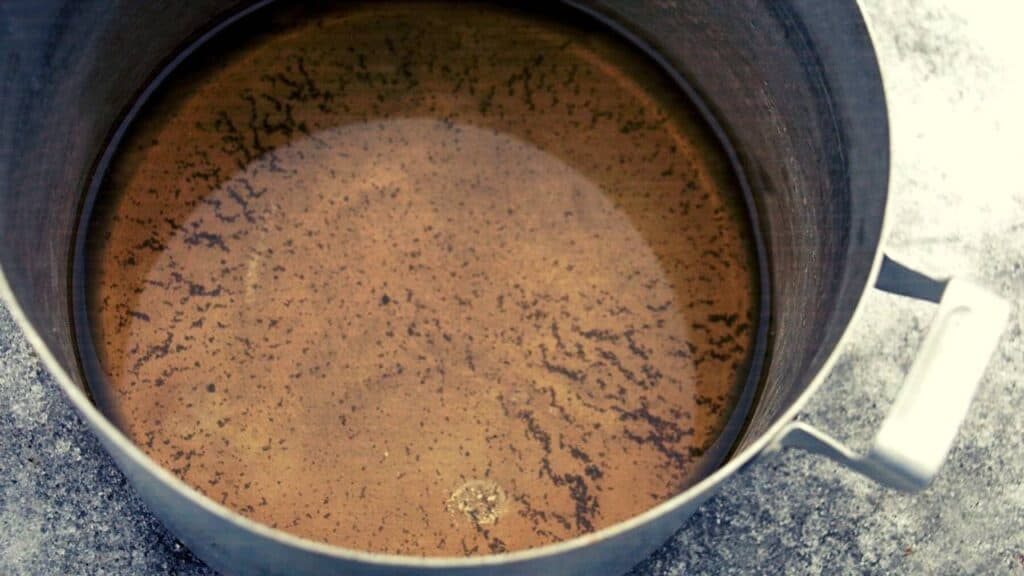
Sources of sediment
Sources of sediment in well water [1] include:
- Leftover sediment from drilling the well
- Dirt and debris from the ground around the well, such as leaves clogging up pump intakes.
- Surface runoff containing dirt and other material picked up by stormwater
- Pipes or other surface structures that are not cleaned properly
- Streams draining through agricultural areas can contain silt from fertilizers and other chemicals, which is then deposited into the groundwater.
City water can also contain high levels of sediment in some areas. Check your water or consider a water quality test if you suspect this is an issue for you.
What is a sediment filter?
A sediment filter, often also known as a pre-filtration system, traps solid particles such as sand, silt, and clay which are found in natural water sources like lakes, wells, and rivers.
Sediment filters are installed before any other types of purification methods to remove these large solids so they do not clog later stage filtration, or clog pipes and household appliances.
Why filter sediment?
The goal of a sediment filter is to remove sediment and other contaminants from your water source.
Sediment filters are most often used for well water because it contains particulates like sand, silt, dirt, clay, pebbles and even small bits of metal from drilling equipment. But city water can also contain sediment too (although usually at much lower levels).
A sediment filter is most commonly used as a pre-filter, meaning that it is installed before the main water filter. This helps to remove sediment and particles from well water that could clog the main water filter.
The dangers of sediment in well water include:
- Sediment has the potential to clog pipes in your home or appliances
- Clogged pipes can increase water usage
- Later stage filters will not function properly if they are clogged up with sediment
- Later stage filters will need cleaning and replacing more often
- If the later stage filter is not functioning properly, it will not be able to remove contaminants from the water
How do I know if my well water needs a sediment filter?
The easiest way to determine whether your well water is contaminated with too much particulate matter, clay, or other material is by taking a look at it in its raw form.
If you see any dark-colored particles, a buildup of sediment on the bottom of your well, or even cloudy water then you likely need to install a sediment filter.
Even if you don’t see any evidence of contamination, basic water analysis should always be carried out as sediment particles can be invisible to the naked eye.
Types of Sediment FIlters
There are several types of filtration methods for sediment. Here are the most common.
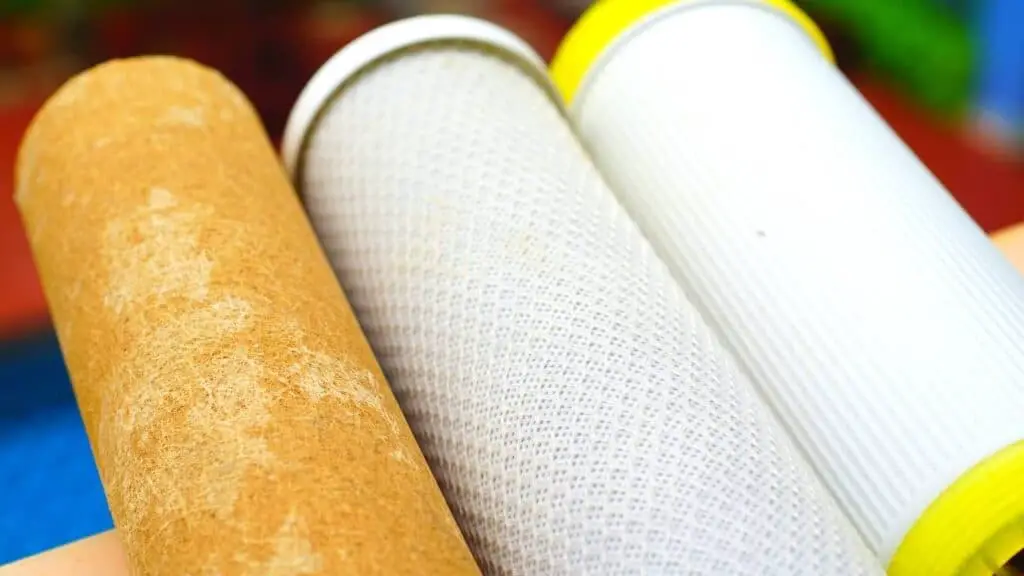
Pleated Filters for Sediment
Pleated filters are a kind of surface filter. They usually come in a cartridge that needs to be changed every few months. These filters work by trapping particles and the pleats that cover them act as a screen, preventing the sediments from passing. Pleated filters are made of either paper or polyester. [2]
These sediment filters outperform depth-type sediment filters because they have increased surface area, which means a longer life span. Pleated filters also cause lower pressure drops than other sediment filters, so flow rates are much higher.
Pleated filters work best in situations where the particle sizes to be filtered are of a similar size.
The downside to pleated filters is that they can be damaged if the water pressure is high. These filters also do need changing eventually, so you should factor that into your overall costs.
Melt-blown filters for sediment
Melt-blown filters are a type of depth filter that is made of melt-blown polypropylene. They work by filtering water as it passes through a thin layer of melt-blown fibers which have been spun into long threads.
This type of sediment filter can remove dirt, sand, silt, and other particulates from the water supply as the fibers act to catch them in its structure. Melt-blown filters are better for situations where there is likely to be a large variety of particle sizes in your water source.
The downside to melt-blown filters is that there’s a much higher drop in water pressure [3]. They don’t last as long either.
String-wound & spun filters
These both work similarly and there doesn’t tend to be much difference between either type.
String & spun filters are examples of depth filters that use multiple layers to trap contaminants. Typically, the outer layer catches any particles that exceed the micron rating, while the inner filter traps smaller ones that may slip through.
This increased filtration comes with a trade-off in reduced surface area, requiring you to replace and clean them more often than pleated filters.
Spin-down sediment filters
Spin-down sediment water filters use a mesh screen instead of a cartridge filter. They work by letting water flow through the thin mesh as it rotates. These meshes are usually made from polyester fibers or stainless steel.
Spin-down filters are one of the most effective types of sediment filtration and are usually recommended for water sources with high levels of contamination. People will often upgrade to a spin-down filter when they find their pleated filter system gets dirty and clogged too quickly.
The downside of this type of sediment filter is that they can be much more expensive. They also need regular flushing. So if the system doesn’t have an auto-flush feature, you’ll need to remember to flush it around once per week.
How to Choose the Best Sediment Filter for Well Water
Choosing the right sediment filter for your well water will depend on several factors. Make sure you understand these, and how they are likely to affect your results.
Well Water Quality
Before buying a sediment filter, make sure that you understand your well water quality.
Well water should be tested regularly to find out what levels of minerals and contaminants are in the water supply. You may need a different sediment filter than for someone who’s on city water or bottled drinking water.
Contamination levels
The type of sediment filters that you’ll want to use will depend on your level of contamination:
Low & medium levels with uniform particle sizes: If your well has low-level sediment contamination with mostly uniform particle sizes, then a cartridge filter system with a pleated paper or polyester media should do the trick. Low levels are more common for city water.
Low & medium levels with varied particle sizes: In this case, you may want to consider a depth filter (eg. melt-blow, string-bound, or spun). They do a better job at filtering out different-sized particles, however, you’ll need to clean and change them more regularly.
Medium & high levels: If you have medium or high-level sediment contamination, then choose from one of the spin-down filters that have a polyester or stainless steel mesh screen. These spin-down sediment filters are also more effective at removing particulates from your drinking water supply than other types of depth filtration systems.
Micron rating
A sediment filter should have a micron rating which can be used to determine how well the filter traps contaminants [4].
Micron ratings tell you how large the holes in a sediment filter are.
The higher the micron rating, the smaller this hole is and so fewer contaminants will be trapped by it. Conversely, the lower the micron rating, the better it is at trapping smaller particles.
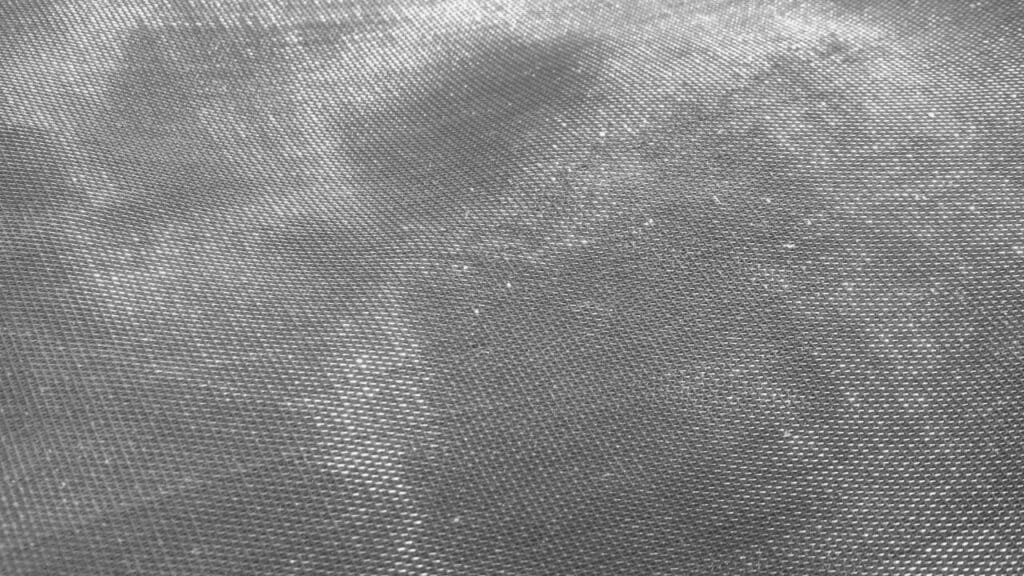
A sediment filter is not designed to catch very small particles, so you don’t tend to find them with micron ratings lower than five. They are designed to filter out larger contaminants and protect the filters or appliances (eg. water heaters) that are downpipe.
If you want to filter out smaller particles, consider further filter stages or a whole house water filter with several stages.
One exception to this rule is when you want to pre-filter well water for a reverse osmosis system. Reverse Osmosis membranes can clog and need changing very often, so people often use sediment filters rated as low as 1 micron to protect them and ensure the highest quality drinking water.
Water Pressure & Flow Rate
Sediment filters can have a big impact on your pressure, so it’s important to consider this before buying one.
An average family home has a water pressure of around 40 to 60 PSI. To test your home’s water pressure purchase a pressure gauge.
If you have low water pressure, you may want to consider fixing that before installing a sediment filter. As every filtration stage that you have will cause at least a small amount of pressure drop. This will likely result in a noticeable drop in flow rate.
If you have higher water pressure, this is likely not a problem. Just check that your sediment filter is capable of handling higher pressures. The maximum pressure for these filters usually ranges from 90 – 150 PSI.
Micron Rating vs Flow Rate
The higher your micron rating, the lower your flow rate will be.
If your home has low water pressure, you may want to consider compromising with a higher micron rating to avoid a drop in flow rate.
Lifespan
The lifespan of your filter is dependent on two things: the type of contaminants that it’s filtering out from the water supply and how much flow rate needs to pass through it daily. This information can usually be found in the product specifications for the filter.
Micron Rating vs Lifespan
If you have low water pressure and a high micron rating, then your sediment filter will need to be replaced more often.
Installation
Do you have enough room for a sediment water filter? Will it fit in your basement alongside other equipment?
This is important because a good installation will help keep any water leakage from happening and could save time on repairs. If there isn’t enough space, find an alternate spot that doesn’t already have plumbing in place.
If there’s no way of installing the filter without impacting other systems, then consider hiring someone who can do this for you. A fully-trained plumber can be hired cheaply.
Sediment filters are tricky things to install properly. So if you’re not sure about doing it yourself, don’t be tempted by those DIY videos!
Manual or auto-flush?
Spin down filters need to be flushed to keep them clean and operating as efficiently as possible.
You can flush a spindown filter by opening the bottom valve for a few seconds. This creates enough pressure to flush and rinse the screen of dirt, debris, and sand.
If your filter is manual flush then you’ll need to remember to do it periodically. But if you have a sediment filter with an auto-flush valve, then this will happen automatically, and you won’t need to remember to do it yourself.
Filter Housing
If you’re buying a spin-down filter, make sure the filter housing is clear. This will allow you to look through and see when the filter is blocked and needs flushing, or to spot any other problems.
Some models have opaque filter housing, and this is not ideal.
Warranty
Most sediment filters have a warranty of at least one year. However, there is a difference between the “lifetime” of the filter and the warranty period.
The lifetime refers to how long you can expect your system to last without needing any repairs or replacements made due to wear and tear from filtering water through it.
If you’re considering one of the more expensive models on this list, it’s worth checking out the length of the manufacturer’s warranty. The longer it is, the more confident they are in their product. And the more protection you have if something goes wrong!
Frequently Asked Questions
What size micron filter is best for well water?
Your micron rating is determined by the amount of sediment that you want to filter out. A lower micron rating filters out more, and a higher micron rating filters out less.
Usually, sediment filters for well water are used as a pre-filter to extend the lifespan of your main water filter. For UV or reverse osmosis filter systems a pre-filter of at least five microns is recommended. For other filtration methods, a 50-micron rating is usually adequate.
Where do you put a sediment filter for well water?
Your sediment filter should be installed just before your main water filter.
Many people install them in the basement alongside other equipment, but you’ll need to check for adequate space and make sure that it doesn’t impact any existing plumbing systems. If there’s no room available, consider installing outside of the house.
How often should I change my sediment filter?
The lifespan of your filter is dependent on the type of contaminants that it’s filtering out from the water supply as well as how much flow rate needs to pass through it daily.
If you have low water pressure and a high micron rating, then your sediment filter will need to be replaced more often.
The exact lifespans can usually be found in the product specifications for the filter, but you should also pay attention to your water quality and flow rate. If you notice any reduction in performance, you may need to change your filter.
If you purchase a spin-down filter there is no cartridge to replace. Just make sure to flush the system regularly and replace the mesh screen if it becomes damaged.
What type of sediment filter systems are best?
The most popular type of sediment filter is the spin-down filter. We recommend this type of filter as they are usually most effective, don’t need replacement cartridges, and can be purchased with auto-flush valves for minimal maintenance.
This kind of sediment filter uses a mesh screen to trap any solid particles in the water that moves through it.
There are other types of sediment filters for well water too. You’ll need to decide which type works best with your system.
What should I do if my sediment filter clogs?
If you have a manual flush spin-down sediment filter then just open up the bottom valve for about five seconds. Wait until you see clear water coming out of the top again or hear flushing sounds. This is enough pressure to dislodge a buildup on the screen mesh.
An auto-flush spin-down sediment filter requires no attention from you unless there’s an obstruction in one of its screens, at which point it will signal that something needs to be fixed.
For a cartridge-based water filtration system, remove and clean the filter media. Or consider replacing the cartridge completely.
Do I need a sediment filter for well water?
You should have a sediment filter if you drink well water as it will remove any solid particles that can cause an unpleasant taste.
Some sediment can be black and easy to notice, but not all types of sediment are visible or noticeable so it’s important to have it installed before the water hits your main filter.
A sediment filter will also help extend the lifespan of another water filtration system in your home, like UV or reverse osmosis filters. This is because sediment can clog the pores in these types of filters and reduce their efficiency.
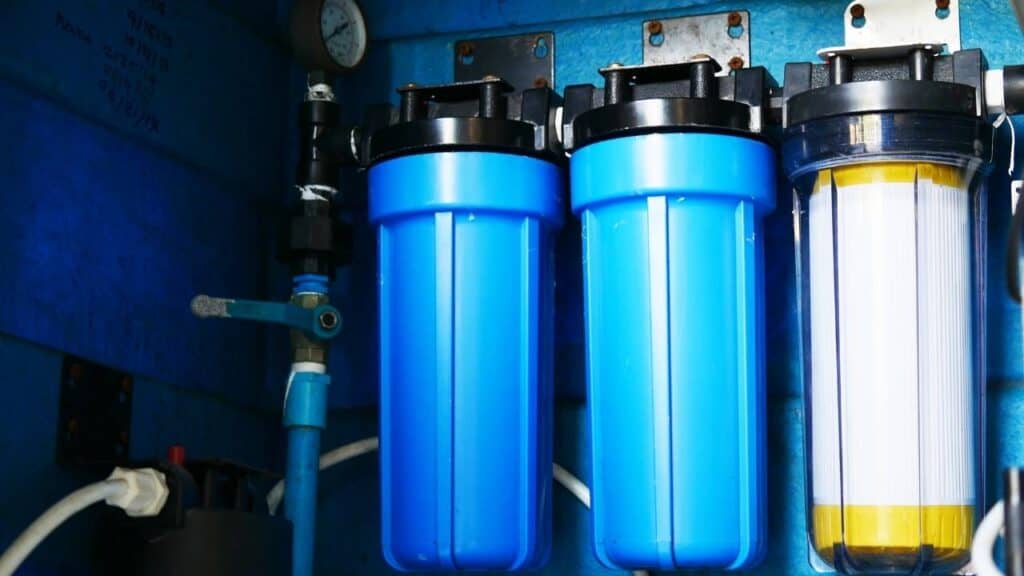
Key takeaways for choosing the best sediment water filter
Get a water quality test if you’re not sure how much sediment is in your water. Once you’re sure, think about which water filters and appliances are downpipe and choose the correct micron rating. A cartridge-based well water sediment filter may not be suitable for high levels of contamination as you’ll need to change the filter too frequently.
Finally, think about your budget and how much maintenance you’re sediment water filter may need. Most spin-down models have clear sediment filter housing to help you see when it needs flushing. If you have a little more budget, go for a model with auto-flush.
The best whole house sediment filter is the iSpring WSP50ARB Spin Down Sediment Well Water Filter. It has clear filter housing, an auto-flush feature, and requires very little maintenance.
Thanks for reading and don’t forget to check out our other reviews of the best well water filters.
Happy filtering!

